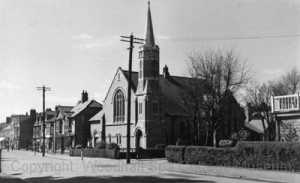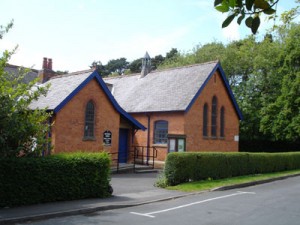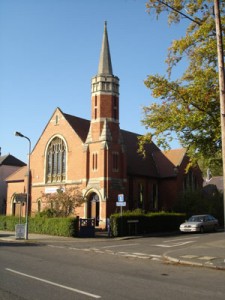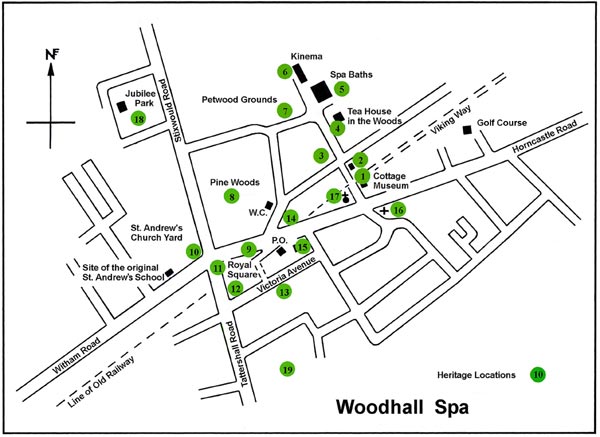Heritage Trail Location 17

Photo 1 - The Methodist Chapel, taken in about 1930 from outside St Peter’s Church, looking down Broadway towards Woodhall Spa Station. The original (and present) chapel can be seen to the rear of the chapel. Photo courtesy of Woodhall Spa Cottage Museum.
A Methodist chapel was built on Witham Road, Kirkstead in 1875. At this time, Kirkstead was not seen as part of Woodhall Spa. Consequently, staunch Methodists, Mr. and Mrs. A. E. Belton, Mr. T. S. Chapman and Mr. G. Overton pressed for a house of worship in Woodhall Spa itself. A private donor supplied money and gave the land, which had belonged to Mr. Blyton, nurseryman behind the Broadway, to the Trust. This was in 1898. The building of a small, combined chapel and schoolroom was accomplished in 1899. It is fitting that the first child to be christened in the new chapel was Ivy, the daughter of Mr. and Mrs. Belton.
Seven years later, this chapel was too small to accommodate the congregation of this rapidly growing village. Consequently, in 1906, many money – raising events were held to fund a new building in front of the chapel, adjacent to the Broadway. There was a Bazaar, a Sale of Work by the Ladies’ Sewing Class, a Bachelors’ Tea, given by the Young Men’s Bible Class and an Entertainment performed by the Sunday School scholars and other events, as well as donations, which procured the necessary money to begin the building.
Foundation stones for the new chapel were purchased by generous benefactors. On the “wild and wintry” afternoon of the 29th January 1907, “notable persons” and “the local Methodists” congregated for a ceremony at which foundation stones were laid. The sky became very dark and snow fell heavily, but the intrepid Methodists were not dismayed. Sundry objects, including a bottle of coins and a copy of the “Horncastle News” were placed underneath the stones.
After the ceremony, the gathering repaired to the Winter Gardens of the Royal Hotel “to partake of tea”. This was followed by a public meeting at which there were hymns, addresses and solos rendered by a Madame Strathearn, A.R.C.M of London.
The cost of the building was estimated at £4000 before the addition of the spire. The opening ceremony for the chapel was on 5th August of that year. This time the weather was described as “lovely”. The Boys Brigade and Sunday School scholars marched to the chapel, led by a Bugle Band. There, proceedings were delayed because a train was half an hour late. The Superintendent Minister of the Coningsby circuit addressed the gathering from the chapel steps. He said that the land occupied by the building had been purchased for the purpose 18 years previously, by Mr J Rivett of Horncastle. Then Mr George Lewis, a native of Woodhall Spa, now residing in Lincoln, was handed a special key and with a bugle salute, the chapel was declared open for worship. After the service, taken by the President Elect of the Methodist Conference, there was a public lunch followed by another service in the afternoon, a meat tea in the schoolroom and a public meeting at 6.30, so well supported that some people were unable to get in. Madame Strathearn, was once again in full voice and “received a hearty reception”.
At the conclusion of the evening, a special train left Woodhall Junction for Lincoln.

Photo 2 - The original 1899 chapel and schoolroom (2005)
The chapel was reported as seating 425 persons and it was complete with vestries and an organ chamber, next to one of the transepts, which the choir would use. The organ was small, with hand bellows, but lasted until 1934, when it was replaced , at a cost of £430, by a pipe organ.
The new chapel was described as “Quite an ornament to the Spa”.
The first christening in this new church was of T. W. Harrison, who grew up to be a Methodist minister.
The chapel soon had a sizeable congregation, with a Sunday school and various mid week meetings and clubs.
The peaceful tenor of chapel life changed during the Second World War. The schoolroom was commandeered by the army for use as a cook room. Servicemen, from the many units stationed in Woodhall Spa, which included the Sherwood Foresters, Somerset Light Infantry, Scottish Borderers and Royal Inniskillin Fusiliers, flocked to the Sunday services. Some were later killed in action.
In 1945, a Thanksgiving Service was held in the chapel after the raid on Arnhem, in which local units had taken part.
A local member of the congregation, Mr. Jack Bycroft, lost his life when the ‘Memphis’ was sunk by enemy action in 1945.
In 1943, the building suffered some damage when bombs were dropped on the village and in 1949 it was closed for repairs, between May and November, during which time the Sunday schoolroom (the original chapel building) was used.
The 50th birthday of the building of the church was remembered with several special Jubilee services in 1957.
However, in common with many places of worship, of every denomination, congregations at Sunday services were considerably less than at the beginning of the century. Old photographs of Sunday school outings of that time showed 80 children, compared with 25 in 1957. The trend continued during the second half of the century and then the Trustees of the chapel were told that the building required not only repairs but an entirely new roof! It was therefore decided, no doubt with sadness, that the large chapel should be sold and the proceeds used to alter the old building to make it suitable for Sunday worship, Sunday school, social events and meetings.

Photo 3 - Methodist Chapel in 2005
Woodhall Spa Parish Council were soon aware of the proposed sale of the chapel and after some consideration, decided that if possible it should be bought for the village for use as a village hall. By doing so, an interesting old building would be preserved, an undesirable replacement would be avoided and, with the increasing number of new properties being built, the larger population would be catered for. A public meeting was held in the summer of 1992, when an architect’s feasibility study was read out and the Council was given a mandate to purchase.
In February of the following year a meeting was held, without press or the public, to consider bidding for the building, at a price suggested by the District Valuer. This suggested bid was then offered to the Methodist Council and Charity Commission. A Councillor, who was against the purchase of the chapel, was concerned about the correctness of this procedure and resigned. Despite the explanation that a “closed doors” bid was standard practice so that other bidders would not know the proposed figure, there was talk of underhand practice, which added fuel to the flames of those who were already concerned about the possible purchase. The main objection was, inevitably, the cost to the council tax payer but many questioned the need for another function hall, other suggested improvements to Coronation Hall would be a better use of council money and questions as to parking and congestion in the area were also raised.
The Council protested that the proposed “Lord Cheshire Memorial Hall” would add only approximately 15p per person per month to council tax but by this time Woodhall Spa had become a village divided over the issue and an extraordinary number of letters on the subject appeared in the Horncastle News.
Feelings culminated in a Parish Meeting of 250 residents with many more having been turned away. The atmosphere was described as “explosive” and words such as “vindictive, abusive and acrimonious” were used in the press reports afterwards to describe the anti purchase campaigners in the “Battle of Broadway”, the reporter expressing his astonishment at the “depth of venom” shown. It was decided that a village referendum should be held on the matter.
The large Methodist chapel has now passed into private ownership and is being used by a local business.
Heritage Trail locations

The trail can be started at any location, but we suggest you also visit the Cottage Museum to see the photographs taken by John Wield during the heyday of the Spa and items associated with this unique Victorian Spa town.
The Trail is just one of several projects in the hands of the Woodhall Spa Parish Council sponsored Heritage Committee. Click here if you are interested in the committee or their projects.
How well do you know Woodhall Spa?
See if you can identify the location of these architectural features and items of street furniture! Or find the Letterbox (coming soon)
Find out more about the Woodhall Spa Conservation Area